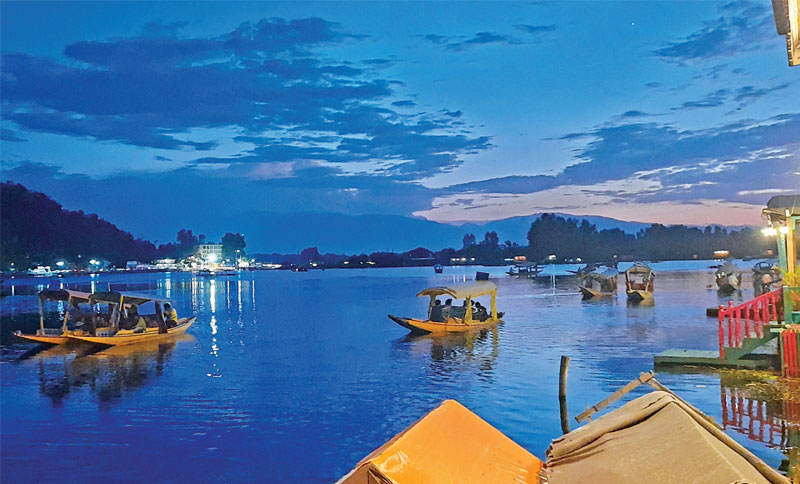How a short visit to Kashmir opened my mind to alternate realities
Smruti D
Had it been any other city, I would be sitting on my preferred aisle seat. But this was Srinagar. And my first visit. After having seen Kashmir on screen, I knew I had to get a bird’s eye view of the city. The moment the aircraft commenced its descent, emerging into the bluest of sky through the clouds, I plastered my face against the window, lest I missed any detail of the rolling greens below. Heaven, indeed, was here.

Then we hit the ground, metaphorically too. The Srinagar airport was a complete mess. Uncountable number of men checking RT-PCR reports greeted me. As I tried to make sense of which way to go, a staffer at the airport stopped me, directing me to go straight ahead towards the exit gate. Just as I started moving as directed, he stopped me again; asking me to go left, where the RT-PCR reports were getting checked. By way of apology for misleading me, he said, “Sorry, I thought you were from the army.” I proceeded left. This was my first interaction with a Kashmiri civilian.
After exiting the airport, once the car hit the road, I couldn’t stop marvelling at the architecture of independent houses as well as the commercial structures with wooden and colourful roofs. How could such housing even be real, wondered my urban self. Our cities are a mess. How had Srinagar remained an exception? Saqib, the driver, used to such reactions said, “It is normal here. When Kashmiris visit cities like Bombay and Delhi for the first time, they are also surprised to see those high-rise buildings everywhere. Here, everyone lives in such houses.”
While marvelling at the architecture, I tried hard to ignore the constant presence of the CRPF personnel on Srinagar roads, but to no avail. Their presence was a part of the city’s architecture—ubiquitous and overwhelming. My thoughts wandered towards the residents of the Valley who had to live under this constant surveillance. If Kashmir had returned to normalcy, why was it necessary for security personnel to be positioned outside grocery stores, parks, pavements, individual homes, and even besides a fruit seller’s handcart?
As I voiced my concern, Saqib said, “This is normal here.” I bristled at his use of normal for everything. It seemed using the word ‘normal’ was normal these days. To me, Saqib’s tone seemed one of indifference. But during my time in Kashmir, as I met different people, I realised that he was not an exception. Almost all of them regarded the overwhelming presence of the security forces in the same nonchalant manner. I mistook helplessness for indifference.
Even as pictures from Srinagar had added to my imagination, the presence of barbed wires and their frequency was astonishing. The tall walls of the CRPF camps had barbed wires, neatly placed at a distance from the walls to prevent trespassing. In one of the busy chowks, the wires were placed on the divider of the already narrow road, obstructing movement. As all the vehicles stopped at the signal, two men attempted crossing the road. Just as I was thinking how bizarre it was to place such a thing in the middle of the road, the men hopped onto the left corner of the divider, the only free space for crossing, and casually walked to the other side. The careless placing of such wires was done notwithstanding the fact that pedestrians or two-wheeler riders could get hurt because of this on a busy street. Just like the word encounter and military has become a part of their day-to-day lingo, symbols of oppression like the barbed wires too have become a part of their lives. No one bats an eyelid even when they are encumbrances.
On the second day of my trip, I was travelling from Srinagar to Pahalgam. Soon after leaving Srinagar, our vehicle had to wait for nearly 40 minutes near one of the CRPF camps owing to the passage of a CRPF convoy. As I began to get restless, the driver Ayyub, urged me to be patient.
“We have no choice but to wait until the convoy has passed,” he said calmly.
No sooner had the car started to move, we came across another convoy and had to wait patiently once again. Sensing our frustration, Ayyub said, “We end up wasting a lot of time even when we have to travel a short distance. Take Pahalgam, for instance. The travel time between Srinagar and Pahalgam is not more than three hours, despite usual traffic. However, sometimes, because of the convoy movement, half a day is spent on reaching Pahalgam.” The trick to avoid that, according to Ayyub, is to leave before 9 in the morning. That way you get a head-start on the convoy movement.
Ayyub was a tad bit expressive. Along the way, we stopped at Pampore, and he told me about the authentic Kashmiri dry fruits one could find in shops in the area. According to him, all the shop owners were mostly the farmers who sold their own produce in these shops. For the first time, I tasted the rich and authentic Kashmiri Kahwa in Pampore. From there, as we started again, I began taking pictures of the beautiful paddy fields that lay on both sides of the highway. Standing at short distances in the fields, were security personnel. Every time we passed them on the highway, Ayyub urged me to lower my phone. After a point, I asked him why he kept saying it. What possibly could happen if they see me taking pictures.
You must be logged in to view this content.

